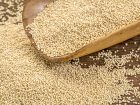
Innovation, Tradition
May 1, 2015
By Chris McGregor
 The sleek, ultra-modern Montréal Convention Centre (Palais des congrès de Montréal on the opposite page) will be the epicentre of innovation in the baking industry when Bakery Congress 2015 rolls into town this month photography Marc Cramer
The sleek, ultra-modern Montréal Convention Centre (Palais des congrès de Montréal on the opposite page) will be the epicentre of innovation in the baking industry when Bakery Congress 2015 rolls into town this month photography Marc CramerSugar-free, gluten-free, low-sodium and clean labelling have become ways of life for lovers of baking products, either through choice or necessity, and this demand leads to new opportunities for bakers and baking ingredient suppliers.
“Gluten-free has taken away from sales of traditional bread products, but has provided a niche market for some bakers,” says Halifax-based David R. Bryson, eastern sales and marketing manager with P&H Milling Group.
“Low sodium bread products have increased the sales to customers looking for lower sodium in their diet. No added sugar bakery products have provided a niche market for bakers as well.”
These trends will be among the new products and innovations showcased at the 2015 Bakery Congress coming to Montreal’s Palais des congrès May 31 to June 1 and organized by the Baking Association of Canada (BAC). The theme of this year’s event is “Innovation Through Tradition.”
Paul Hetherington, president and CEO of the Baking Association of Canada, said the theme reflects a return to a simpler style of baking.
“It’s symbolic in [a] business where we are looking at products and how to make them more natural. How can we do more using the fundamentals on how things were made 60 to 80 years ago?” Hetherington says.
Dan Peroff, BAC’s Ontario chapter chair and president of Olympic Wholesale – the Ajax, Ont.-based ingredient supplier – agrees that the specialty market is the focus in 2015, with plenty of room for sales growth.
“The trends flow as fast as the wind can carry them; this is great for our industry as it creates new items to offer to consumers who believe that these above mentioned trends will be the answer to their ailments,” Peroff says. “The demand is still on the low side of sales in [the special diet category] but they continue to sell. Those bakeries that search for trends and create products that meet them will succeed in the future.”
Gluten-free Market Remains Strong
In a 2014 report on bakery trends by the Guelph Food Technology Centre (GFTC), now part of NSF International, says demand for gluten-free (GF) products increased by 44 per cent between 2011 and 2013.
Sales of gluten-free products reached $10.5 billion in 2013 and are expected to grow by 48 per cent by next year, according to the study.
While most consumers who eat gluten-free food have celiac disease or are allergic to wheat or other grains, the study goes on to explain that that’s not always the case. In fact, 65 per cent of those eating GF foods do so because they think it is a healthier dietary choice, while 27 per cent believe a GF diet leads directly to weight loss.
“Healthy choices and food safety seem to be the trends at the forefront right now,” explains Ron Létourneau, president of Ventes Rudolph, a Quebec-based ingredient manufacturer with over 3,400 baking products designed with the artisan baker in mind.
He added that the artisan baking community is slower than other sectors to change direction towards healthier baking.
“They truly are into indulgent baking. However, the gluten-free and sugar-free segments have taken flight in the last few years. Honestly, in the Quebec market, low-sodium is not an issue that is getting a lot of attention from the artisan crowd,” Létourneau says. “It is, however, a large concern in other segments and a valid health concern.”
While specialty baking products are not the company’s key area of focus, L<1>é</1>tourneau says they are responding with product lines that do fit with the restrictions of a gluten-free or low-sodium diet.
“It will find a way to the artisans in time and we will be ready for that challenge.”
In the past, consumer demand dictated a need for freshness, while the grocery industry wanted a longer shelf life. Today, consumers needs have come full circle, thanks to clean label initiatives and a desire for ingredient lists that can be easily pronounced.
“We’re trying to go back to the way they were 100 years ago, under the guise of ‘this is healthier for us.’ The industry is following the demand,” Hetherington explains.
Clean Labelling Takes Flight
While consumers are concerned about what they’re eating and in what quantities, there is a move toward clean labels that cut back on the number of ingredients contained in food.
Clean labels are defined as being transparent in their ingredient lists, with concise, clearly defined labels that contain natural ingredients while eschewing jargon, artificial flavours and chemical additives. In short, consumers are seeking products that are more natural and therefore better for them.
According to consulting firm Innova Market Insights, the number of clean label products launched in North America jumped from 1,151 in 2003 to 6,211 in 2011.
GFTC’s study indicated that clean labeling was the leading trend of 2012, but the movement continues to gain importance in 2015 and beyond. It indicates that “consumers want to go back to nature” by “seeking minimally processed baked goods containing fewer additives and preservatives.”
Olympic Wholesale’s new line, Pure Food Products, meets the expectations of clean labelling and the health demands of savvy shoppers who want to know what they are eating.
“Driving ingredients sales is all-natural preservative-free, and conversions of the standard artificial products over to … no artificial colours or flavours, non-hydrogenated, and no preservatives,” Peroff explains.
Olympic is currently working with its vendors in starting to convert products that can be easily produced to meet clean labelling requirements while adding minimally to core ingredient costs.
Hetherington points out the move by Dunkin’ Donuts to eliminate titanium dioxide, a whitening agent used in powdered sugars, following a campaign by the organization As You Sow, which labelled titanium dioxide a toxic substance, as an example of a clean label. The goal is to ensure that consumers can read and understand everything that is in the foods they eat.
Last year, Subway removed a chemical from its breads called azodicarbonamide that is also found in yoga mats and shoe rubber. Subway used the chemical to bleach the flour and to make the dough easier to use. It is also found in certain pesticides, according to the World Health Organization.
“We realize the demand for clean label,” Hetherington says, adding that changes to recipes and processes come with their own set of challenges that needs to take into account the needs of consumers and cost-effectiveness for producers. “There is always a happy medium that needs to be achieved.”
For the baking industry, the GFTC says the sector faces numerous challenges when it comes to capitalizing on the clean label trend. Consumers are also looking for food that is great-tasting, safe and cost effective, while retailers are interested in maintaining a long shelf life for their products.
“The push to have all links of the distribution chain adopt and embrace solid food safety practices is, in my mind, the most prevalent of the trends,” Létourneau says.
Frank Safian, a technical sales representative with P&H Milling Group, handles flour sales in Canada and the United States for the baking industry. He believes that proper labelling can mean the difference between success and failure of a product.
“All food manufacturers continue to be asked to improve their ingredient and nutritional claims that give consumers healthier alternatives,” he says.
“Clearly consumers have choices to make, however more consumers are looking at ingredient declarations, allergen claims and health branding backed by various societies like the Heart and Stroke Foundation. Manufacturers that choose to use healthy messages on their packaging seem to be winning the media and message war.”
More information about the 2015 Bakery Congress is available online at www.baking.ca.
Print this page


Leave a Reply